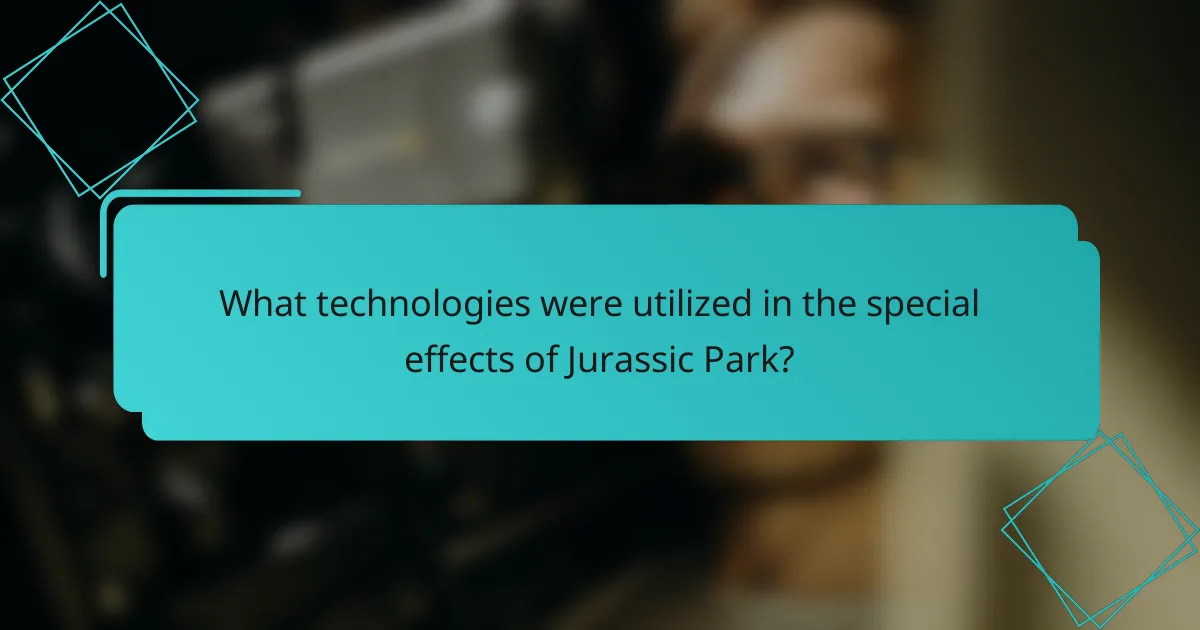Jurassic Park is a landmark film known for its revolutionary special effects that combined animatronics and computer-generated imagery (CGI) to create lifelike dinosaurs. The animatronics, developed by Stan Winston Studio, provided realistic movements, while CGI from Industrial Light & Magic showcased advanced rendering techniques, particularly in the iconic T-Rex chase scene. This innovative blend of practical effects and CGI set new standards for visual storytelling in cinema and influenced numerous films that followed. The article explores how these techniques enhanced realism and storytelling, emphasizing the importance of lighting, pacing, and the integration of effects in filmmaking.

What are the Revolutionary Special Effects of Jurassic Park?
Jurassic Park utilized groundbreaking special effects that revolutionized the film industry. The film combined practical effects with cutting-edge CGI to create lifelike dinosaurs. The use of animatronics, developed by Stan Winston, allowed for realistic movements and interactions. CGI was pioneered in scenes like the T-Rex chase, showcasing advanced rendering techniques. The film’s iconic scenes set new standards for visual storytelling. It was the first major film to use CGI alongside animatronics on such a grand scale. This innovative approach influenced countless films that followed. Jurassic Park remains a benchmark for special effects in cinema.
How did Jurassic Park change the landscape of special effects in film?
Jurassic Park revolutionized special effects in film by integrating cutting-edge computer-generated imagery (CGI) with practical effects. The film showcased realistic dinosaurs created through a combination of animatronics and CGI. This marked a significant shift from traditional methods that relied heavily on models and puppetry. The seamless blending of these techniques set a new standard for visual storytelling. Jurassic Park’s success demonstrated the potential of CGI to create lifelike creatures, influencing subsequent films. It also spurred advancements in technology, leading to more sophisticated visual effects in the industry. The film’s impact is evident in how modern blockbusters utilize CGI to enhance realism and narrative.
What techniques were pioneered in the creation of special effects for Jurassic Park?
Jurassic Park pioneered several groundbreaking techniques in special effects. The film utilized a combination of animatronics and computer-generated imagery (CGI). The animatronics were created by Stan Winston’s team, allowing for lifelike dinosaur movements. CGI was developed by Industrial Light & Magic, showcasing realistic dinosaur appearances. The film’s T-Rex scene was a landmark moment for CGI integration. Motion capture technology was also employed to enhance realism in dinosaur movements. These innovations set new standards for visual effects in the film industry. Jurassic Park’s techniques influenced many subsequent films and established a new era in special effects.
How did the combination of practical effects and CGI enhance the film’s realism?
The combination of practical effects and CGI in “Jurassic Park” significantly enhanced the film’s realism. Practical effects provided tangible, physical elements that actors could interact with. This created a sense of authenticity in the performances. CGI, on the other hand, allowed for the creation of lifelike dinosaurs that moved seamlessly within the environment. The blend of both techniques resulted in a more immersive experience for viewers. For instance, the T-Rex scenes utilized animatronics for close-ups, while CGI was used for wide shots. This combination made the dinosaurs appear realistic and believable. The film’s groundbreaking effects set a new standard in the industry, influencing future productions.
Why are the special effects of Jurassic Park considered groundbreaking?
The special effects of Jurassic Park are considered groundbreaking due to their innovative use of computer-generated imagery (CGI) and animatronics. The film was one of the first to seamlessly blend CGI with practical effects. It showcased lifelike dinosaurs that captivated audiences and set new standards in visual storytelling. The T-Rex and other dinosaurs were created using a combination of advanced CGI and life-sized animatronic models. This approach allowed for realistic movement and interaction in various environments. The film’s release in 1993 marked a pivotal moment in the film industry. It influenced countless films that followed, establishing CGI as a vital tool in filmmaking. The special effects in Jurassic Park earned an Academy Award for Best Visual Effects, further validating their groundbreaking nature.
What impact did these effects have on audience perception of dinosaurs?
The revolutionary special effects of Jurassic Park significantly changed audience perception of dinosaurs. The realistic visual representation made dinosaurs appear more lifelike and engaging. Audiences began to see dinosaurs as dynamic creatures rather than mere fossils. This shift sparked greater public interest in paleontology and dinosaur science. The film’s groundbreaking CGI and animatronics set new standards for future films. As a result, dinosaurs became cultural icons, influencing merchandise and educational content. The film’s impact led to increased attendance in museums and dinosaur exhibits. Overall, Jurassic Park reshaped how society views and appreciates dinosaurs.
How did the technology used in Jurassic Park influence future films?
The technology used in Jurassic Park revolutionized special effects in filmmaking. Its groundbreaking use of computer-generated imagery (CGI) set a new standard for visual effects. Jurassic Park was one of the first films to seamlessly blend CGI with practical effects. This combination created a more realistic portrayal of dinosaurs that captivated audiences. Following its release in 1993, many filmmakers adopted similar techniques. Films like The Lord of the Rings and Avatar utilized advanced CGI inspired by Jurassic Park. The success of Jurassic Park demonstrated the commercial viability of high-quality special effects. This led to increased investment in CGI technology across the industry. Overall, Jurassic Park’s technological innovations shaped the future of visual storytelling in cinema.

What technologies were utilized in the special effects of Jurassic Park?
Jurassic Park utilized a combination of animatronics and computer-generated imagery (CGI) for its special effects. The animatronics were created by Stan Winston Studio, which designed life-sized dinosaur models for realistic movements. CGI was developed by Industrial Light & Magic, showcasing groundbreaking visual effects that brought dinosaurs to life. The film’s T-Rex scene is a notable example of this technology blend. The use of CGI allowed for dynamic action sequences that were previously unattainable. The integration of these technologies set a new standard for visual effects in cinema. Jurassic Park’s innovative approach influenced future films in the industry.
How did animatronics contribute to the film’s special effects?
Animatronics significantly enhanced the special effects in Jurassic Park. They provided realistic movements and lifelike appearances for dinosaurs. This technology allowed filmmakers to create tangible creatures that interacted with actors. The use of animatronics complemented CGI, creating a more immersive experience. For example, the T-Rex animatronic was over 40 feet long and operated with intricate mechanics. It was used in key scenes, adding authenticity to the film. The combination of animatronics and digital effects set a new standard in filmmaking. This approach influenced future films in the genre, showcasing the effectiveness of practical effects.
What were the most notable animatronic dinosaurs created for the film?
The most notable animatronic dinosaurs created for the film “Jurassic Park” include the T. rex, the Velociraptors, and the Triceratops. The T. rex animatronic was a massive 40-foot long model, designed by Stan Winston Studio. It was capable of moving its head, jaws, and even its eyes. The Velociraptor animatronics were smaller but highly detailed, featuring intricate skin textures and realistic movement. The Triceratops animatronic was notable for its life-sized scale and was used in a memorable scene with the character Dr. Sattler. These animatronics were groundbreaking in their realism and contributed significantly to the film’s visual impact. They were a key part of the film’s revolutionary special effects, blending seamlessly with CGI elements.
How did animatronics compare to CGI in terms of audience impact?
Animatronics and CGI had distinct impacts on audience perception in “Jurassic Park.” Animatronics provided tangible, physical effects that audiences could see and touch. These effects created a sense of realism and immersion that CGI alone struggled to achieve at the time. For instance, the T. rex animatronic was used in key scenes, enhancing the film’s authenticity.
In contrast, CGI allowed for more dynamic and complex movements. The fully animated dinosaurs could perform actions that animatronics could not replicate. This combination of both techniques captivated audiences, making them feel the dinosaurs were alive.
The film’s success led to a shift in the industry. Many filmmakers began to blend animatronics with CGI, recognizing the strengths of both methods. The audience’s positive response to this hybrid approach influenced future blockbuster films. Overall, animatronics offered a tactile experience, while CGI expanded creative possibilities, together creating a groundbreaking impact.
What role did computer-generated imagery (CGI) play in Jurassic Park?
Computer-generated imagery (CGI) played a crucial role in Jurassic Park by bringing dinosaurs to life on screen. It allowed for realistic visual effects that traditional animatronics could not achieve. The film utilized CGI to create lifelike movements and interactions of the dinosaurs. Notably, the T. rex and the Velociraptors were primarily rendered using CGI. This innovation set a new standard for visual effects in cinema. The seamless integration of CGI with live-action footage enhanced the storytelling. Jurassic Park’s use of CGI was groundbreaking and influenced future films significantly. The film’s success demonstrated the potential of CGI in creating immersive cinematic experiences.
How was CGI integrated with live-action footage in the film?
CGI was integrated with live-action footage in “Jurassic Park” through innovative techniques. The film utilized a combination of animatronics and computer-generated imagery to create realistic dinosaur appearances. Filmmakers employed motion capture technology to animate the dinosaurs, ensuring fluid movements. This approach allowed CGI elements to interact seamlessly with live actors and environments. The integration was further enhanced by careful lighting and shading techniques that matched the live-action footage. The result was a groundbreaking visual experience that set new standards in the film industry. “Jurassic Park” is often cited as a pivotal moment in the evolution of special effects due to this integration.
What challenges did the filmmakers face while using CGI?
Filmmakers faced significant challenges while using CGI in “Jurassic Park.” One major challenge was the technological limitations of the time. The CGI required extensive computing power, which was not readily available. Additionally, achieving realistic textures and movements for dinosaurs proved difficult. Filmmakers needed to blend CGI with practical effects seamlessly. This necessitated meticulous planning and coordination between different teams. The complexity of animating lifelike creatures also posed artistic challenges. Balancing realism with storytelling was crucial to maintain audience immersion. These challenges ultimately contributed to the groundbreaking nature of the film’s special effects.

What lessons can filmmakers learn from the special effects of Jurassic Park?
Filmmakers can learn the importance of blending practical effects with CGI from the special effects of Jurassic Park. The film utilized animatronics and life-sized models to create realistic dinosaur movements. This approach grounded the visual effects in reality, making them more believable. The T-Rex scene exemplifies this, where the combination of animatronics and CGI created a seamless experience. Filmmakers should also note the significance of lighting and shadow in enhancing realism. The film’s use of natural lighting added depth to the CGI elements. Additionally, pacing and timing are crucial for effective special effects. The tension built during key scenes showcases how effects can enhance storytelling. Overall, Jurassic Park demonstrates that a thoughtful combination of techniques can result in groundbreaking visual storytelling.
How can modern filmmakers apply the techniques used in Jurassic Park?
Modern filmmakers can apply techniques from Jurassic Park by integrating practical effects with digital technology. The film effectively combined animatronics with CGI to create lifelike dinosaurs. This hybrid approach allowed for more realistic interactions and visual depth. Filmmakers today can use similar methods to enhance believability in their own projects. For instance, using real sets and props alongside CGI can create a more immersive experience. Jurassic Park’s use of lighting and camera angles also set a standard for visual storytelling. By studying these techniques, filmmakers can elevate their narratives and audience engagement. The innovative effects in Jurassic Park have influenced countless films since its release, showcasing the lasting impact of these methods.
What best practices can be derived from the special effects production process?
Best practices derived from the special effects production process include thorough pre-production planning. This ensures that all aspects of the special effects align with the overall vision of the project. Collaboration among departments is essential for seamless integration of effects into the narrative. Effective communication helps in addressing challenges early in the process. Utilizing advanced technology enhances the quality and realism of effects. Continuous testing and iteration are crucial for refining the effects before final implementation. Documenting the production process aids in learning for future projects. These practices were exemplified in the production of “Jurassic Park,” where innovative techniques set new industry standards.
How can filmmakers balance practical effects and CGI for maximum impact?
Filmmakers can balance practical effects and CGI by using each method to complement the other. Practical effects provide tangible realism that engages viewers. CGI can enhance these effects by adding elements that are difficult to create physically. For example, in “Jurassic Park,” animatronics were used for dinosaur close-ups. CGI was then applied for scenes requiring larger-scale movements. This combination creates a seamless visual experience. Studies show that audiences respond positively to films that blend both techniques effectively. The use of practical effects can ground CGI, making it feel more believable. By strategically planning scenes, filmmakers can maximize the impact of both methods.
What are the future implications of special effects in cinema?
The future implications of special effects in cinema include enhanced storytelling, immersive experiences, and increased accessibility. As technology advances, filmmakers can create more realistic visuals. This realism allows for deeper emotional connections between audiences and characters. Virtual reality and augmented reality are becoming integral to cinema. These technologies provide interactive experiences that engage viewers in new ways. The use of artificial intelligence in special effects can streamline production processes. It can also reduce costs while maintaining high-quality output. Historical advancements, like those seen in “Jurassic Park,” set a precedent for future innovations. As a result, audiences can expect more groundbreaking cinematic experiences in the years to come.
How might emerging technologies shape the next generation of special effects?
Emerging technologies will significantly enhance the next generation of special effects. Innovations like virtual reality (VR) and augmented reality (AR) will allow for immersive experiences. These technologies enable filmmakers to create realistic environments and characters. Artificial intelligence (AI) will streamline the animation process, making it faster and more efficient. Machine learning algorithms can analyze vast datasets to improve visual effects. Additionally, advancements in computer graphics will lead to higher resolution and more detailed imagery. For instance, real-time rendering technology allows for immediate visual feedback during production. This evolution in special effects will likely lead to more engaging storytelling in films.
What trends are currently influencing the evolution of special effects in film?
Current trends influencing the evolution of special effects in film include advancements in digital technology and real-time rendering. The integration of virtual reality (VR) and augmented reality (AR) is reshaping how effects are created and experienced. Filmmakers are increasingly using motion capture technology to create lifelike characters. This method enhances the realism of animated figures in films. Additionally, the use of artificial intelligence (AI) is streamlining the visual effects production process. AI algorithms assist in automating tasks, reducing time and costs. The trend towards blending practical effects with CGI is also notable. This hybrid approach maintains a tactile quality while leveraging digital enhancements. Overall, these trends signify a shift towards more immersive and realistic cinematic experiences.
The main entity of the article is the revolutionary special effects of Jurassic Park. The article provides an overview of how Jurassic Park transformed the film industry through its integration of practical effects and computer-generated imagery (CGI), showcasing lifelike dinosaurs that captivated audiences. It highlights the pioneering techniques used, including animatronics and motion capture, as well as the challenges faced in blending these technologies. The impact of these innovations on audience perception of dinosaurs and the subsequent influence on future films is also discussed, emphasizing the lasting significance of Jurassic Park in the evolution of visual storytelling in cinema.
